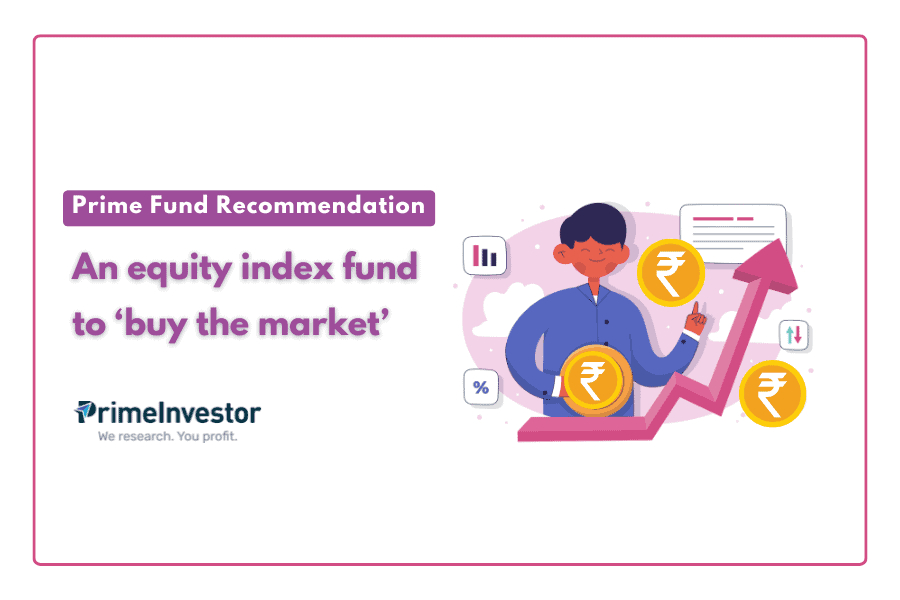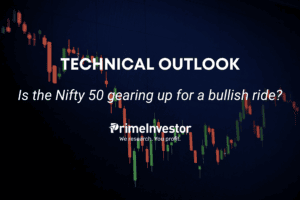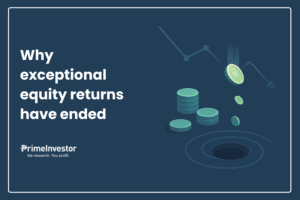In our recent ETF recommendation on a tactical international opportunity, we had outlined a three-pronged strategy to make the best of the current market situation. In this report, we explain the second strategy – a passive index fund to buy into the Indian market, to help you capitalise on the correction, and to focus on India’s fundamentally sound economy. As mentioned in our earlier report, while international funds are useful to add variety, domestic funds should be your portfolio’s mainstay.

That strategy is the Nifty Large Midcap 250 index. The index has dropped about 14% since the September 2024 market peak. Here’s why we think this is a good option to invest in, to play the domestic market:
- The Nifty Large Midcap 250 is a half-and-half blend of large caps (Nifty 100) and midcaps (Nifty Midcap 150), representing a broad slice of the market. This makes it strategically placed to participate in the recovery of both large-caps and mid-caps without the risk of a pure mid-cap index.
- The Nifty Large Midcap 250 is more balanced between the two marketcap segments than the Nifty 500. The latter index is much heavier on large-caps and has a long tail of holdings which may not add to performance.
- The Nifty Large Midcap 250 has, owing to the hefty midcap exposure, outshone the Nifty 500 during market rallies. This again makes it a better option to specifically capitalize on a potential market upswing.
The index fund we are recommending is the Edelweiss LargeMidcap 250 Index fund. The fund is also part of Prime Funds, under the Equity – Aggressive section.
Better index construct
The Nifty Large Midcap 250 comprises the stocks in the Nifty 100 and the Nifty Midcap 150. The weight to these two indices is capped at 50% each. Within this weight, each stock is weighted based on its market-cap.
This 50-50 split between the Nifty 100 and Nifty Midcap 150 is the differentiator in this index. While the Nifty 500 is broader and includes smallcaps, stocks in the index are weighted by market cap. That automatically results in large-cap stocks holding a heavier share – the Nifty 500’s large cap allocation stands around 72%, with midcaps making up 18% and smallcaps the rest.
In terms of sector allocation, the Nifty Large Mid 250 has less concentrated exposure to Nifty 50 heavyweights – finance, IT, and oil & gas. These three sectors make up 44% of the index’s weight, compared to the 49% for the Nifty 500 and 60% for the Nifty 50. The index offers exposure to sectors such as healthcare, capital goods, consumer services, metals & so on which results in better diversification.
Individual stock weights are also more diffused in the Nifty Large Mid 250 owing to the cap on the large cap and midcap allocation. The top 10 stock weights in the index stand at about 24% against the 35% of the Nifty 500. The highest weight in the Nifty Large Mid 250 is 5.7% against the 8.1% in the Nifty 500 (HDFC Bank).
Superior performance
Given its composition, the Nifty Large Midcap 250 straddles the ground between the Nifty 500 and the Nifty Midcap 150 in terms of both returns and risk profile. That is:
Returns: On a long-term rolling return basis, the Nifty Large Mid 250 has returned more than the Nifty 500 but less than the Nifty Midcap 150. Consider performance against the Nifty 500 first. Since the Nifty Large Mid 250 has a heavier weight to midcaps, the outperformance of this market segment during rallies propels higher returns. Against the Nifty 500, the Nifty Large Midcap 250 captures 13% more of the upsides.
On a rolling 3-year return basis over the past decade, the Nifty Large Midcap 250 beat the Nifty 500 about 84% of the time. The consistency figure jumps to 100% on a rolling 5-year basis. The average margin of outperformance is 2%.
Against the Nifty Midcap 150, this fund outperforms only 23% of the time on a rolling 3-year basis, with lower upside capture. This is a given, as Nifty Midcap 150 is entirely mid-caps.
Middle ground on risks: With the higher mid-cap component, the Nifty Large Mid 250 is more volatile, tends towards steeper falls, and has a higher loss probability than the Nifty 500. Therefore, in terms of risk the Nifty LargeMid 250 ranks higher. But it fares better on all counts against the Nifty Midcap 150.
To explain, the average 1-year loss over the past decade for the Nifty 500 is about 7.4%. In comparison the Nifty Large Mid 250 fell 8.3% on an average and the Nifty Midcap 150 dropped 9.6%. In terms of volatility as well, the Nifty Large Mid 250 features higher volatility than the Nifty 500 along with worse downside capture.
In the recent market correction, too, the Nifty Large Midcap 250 and the Nifty Midcap 150 sank 19% and 21% respectively, against the 18% in the Nifty 500. As things stand today, the Nifty Large Mid 250 is down about 14% from the peak.
Another important factor working in favour of the Nifty Large Midcap 250 is its superior performance against active funds in the large-and-midcap equity category. By and large, active funds in this category underperform the index, which is the benchmark for the category. For example, on a rolling 3-year return basis in the past 6-year period, funds have beaten the index just 40% of the time on an average. While active funds do manage reasonably well on the upside, most are unable to sustain this performance. This is unlike categories such as midcaps, where several active funds clock reasonable outperformance over the long term.
Using the index in your portfolio
If you’re looking to include the Nifty Large Mid 250 in your portfolio, keep the following points in mind:
- This is a good fund to buy for first-time investors who are undecided what to buy and can give them exposure to a broad cross-section of the market.
- The index is a versatile one that can be added along with mid-cap or small-cap funds in your portfolio. It can provide a good way to compensate for any underperformance in your active funds; as we have seen, mid-cap and small-cap active funds can slip below benchmark during prolonged mid-and-smallcap rallies.
- The index is suitable for any investor. For more conservative investors who do not want to go for pure midcap or smallcap exposure, it offers a route to participate in these higher-returning market segments. For high-risk investors, where equity allocation is already likely to be high, the index is useful to add higher-return options for comparatively lower risk. The index is also a great one to use for those with small portfolios who cannot hold multiple funds for allocation to different categories.
- If you already own a Nifty Midcap 150 index fund in your portfolio, skip adding this fund. The midcap index would already give you the high-return component, and you would simply be stepping up risks by adding this fund and not diversifying by much. You could, in such a case, look to adding a large-cap index fund instead.
- At this time, lumpsum investments can be done to use the correction to your advantage. Phase out such lumpsum investments in a few tranches to utilize further dips in markets after the recent rebound of the past few days. Of course, whether or not you do such one-time investments, you can always add SIPs as well. The index is a good one to maintain in long-term portfolios.
The index fund recommendation
Our recommendation here is the Edelweiss Large Midcap 250 index fund. For a long while, this fund was the only one on the index; it was launched in December 2021 and we added it to Prime Funds in September 2022. That changed with Zerodha launching its fund in December 2023, followed by HDFC and ICICI Pru lately.
Even with these newer options, our recommendation remains the Edelweiss index fund. The fund manages quite well on tracking error, even with the mid-cap exposure where liquidity can pose a challenge in some smaller stocks. In short-term periods, the fund sports a very low tracking error that is on par with some of the pure large-cap index funds. Over longer-term periods, the error moves up a shade, but not significantly so and is much lower than midcap index funds.
The Edelweiss fund’s average 6-month expense ratio is also low at 0.22 (for the direct plan); the Zerodha fund on the same index comes in at 0.27. Compared to earlier months, especially around the time of launch, the expense ratio has moderated.




14 thoughts on “Prime Fund Recommendation: An equity index fund to ‘buy the market’”
Interesting analysis! I am investing:
40$ in parag parik flexy cap,
30% in ICICI prudential Equity & Debt,
15% each in Nippon Small cap and Edelweiss Midcap activ funds.
Do I take exposure to this fund?
Your exposure to mid-and-smallcaps already seems on the higher side at 30% – assuming of course that the % you have mentioned is your full portfolio and not the equity portion alone. So investing in another higher-risk index is avoidable. – thanks, Bhavana
Thank you.
Hi, I have been investing in the time frame based portfolio funds (>7 years). Should I replace Motilal Oswal Nifty 500 Index fund with this Nifty 250 Index fund? I currently do not have exposure to dedicated small cap funds. My current portfolio includes Parg Flexi cap, Kotak Emerging fund, UTI Nifty 50 funds. Please share your view.
No, there is no need to replace the Nifty 500 index fund with this one, especially in our Prime Portfolio. We have other high-risk exposure there. For Prime Portfolios, we will keep you informed on any changes you may need to make, so please follow only those. – thanks, Bhavana
Interesting analysis.
Can you guide if one has only Nifty50(69%) and Nifty Next 50(31%) in portfolio does it make sense to by Nifty Large Midcap 250 index? I have both MF from UTI. N50 has your buy recommendation where as NN50has hold recommendation . Should it a fresh investment or one should liquidate both N50and NN50 and reinvest in Nifty Large Midcap 250 index of Nippon?
You can replace NExt 50 with this.
Thanks
Hello,
I started out investing a few months ago,
If I want to add this one as a risky investor for the long term how would you recommend me to change my portfolio –
Parag Parikh Flexi has 30%
Nifty 50 Index has 25%
Midcap 150 Index Fund has 15% – Is this where I replace this with the following?
FD 10%
Small cap 5%
Gold 10%
As mentioned in the report, if you already have the Nifty Midcap 150, there is no need to add the LargeMid 250. You would be upping the risk without diversifying much. You can continue with your existing funds. – thanks, Bhavana
LargeMidcap 250 Index has 50% into midcap 150 index. PE ratio for midcap 150 is 36.2, isn’t this overvalued and not right time to invest specially lumpsum ?
We have recommended lumpsum investments in tranches based on market movements and not a single lumpsum investment now. This apart, PE needs to be in context of movement and not on an absolute basis. The correction has already moderated PE levels for the midcap index, and further dips from here can make it more favourable. Slower earnings growth has also resulted in somewhat higher PEs. The LargeMidcap 250 PE levels are much lower than the Midcap index. Also, when looking at investing in an index, the call is also based on how much further correction it can see. – thanks, Bhavana
how do you compare this Edelweiss passive fund with something like Motilal large and mid fund? I know the later’s standard deviation is much higher but so is the alpha
Please check our buy/sell/hold calls for our view on individual funds. If you hold the Motilal fund, you can continue to do so. The call on the Large Mid 250 index is specifically to play the market. The point of an active fund is to beat the index – so it necessarily needs to have a higher alpha. There are a few active funds in the large-and-midcap category that are doing well against the index; but by and large, in this particular category, it is more an exception than the norm. – thanks, Bhavana
Comments are closed.